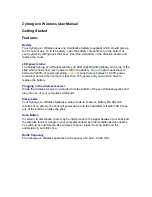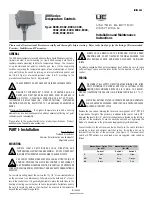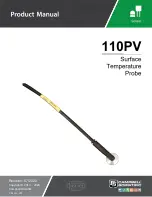
-
Appendix
Controller Grounding System Installation
To prevent lightning damage to your equipment,
Rain Bird recommends installing a grounding system
for the equipment (including controllers, weather
stations, and central control systems)�
The grounding system discharges lightning-induced
electrical current into the earth rather than allow the
surge to pass through power wires or field wires to
your equipment’s electronic components�
Ground Resistance
Ground resistance occurs when grounding system
components, or the soil itself, oppose the flow
of electricity into the earth� Ground resistance is
measured in units called “ohms” (Ω)�
The higher the ground resistance (higher ohm
readings), the less chance the surge will be shunted
to ground rather than to the equipment’s electronic
components�
Figure 18 shows points where grounding systems can
develop resistance�
To decrease ground resistance, Rain Bird recommends
irrigating the soil around the grounding system�
Each grounding system may require a dedicated
irrigation zone with sprinkler heads and its own
watering program to maintain soil moisture around
the grounding system�
A good grounding system should maintain a ground
with a resistance of 10 ohms or less� Anything 15 ohms
or greater offers little protection to the controller’s
electronic circuits�
If you are unable to reach a resistance of 10 ohms
or less, you can enhance the ground network with
additional ground electrodes or plates�
Installation Requirements
The following requirements apply to all grounding
system designs (design “Y” and the “Grounding Plate”
design)�
All grounding rods or plates must be connected
together below grade with #6 AWG or larger solid
bare copper wire�
Install the connecting wire in as straight a line as
possible� If you must make a turn or bend in the wire,
make the turn in a sweeping curve with a minimum
radius of 8” and a minimum included angle of 90°�
To minimize resistance, the copper wire must be
pre-welded to the grounding rods/plates, or welded
to the rods/plates using an exothermic welding
process at the site�
Make sure all welds are secure before burying the
grounding rods� Rods and plates with welded joints
do not need periodic visual inspection and can be
fully buried (no valve box required)�
Measure the ground resistance around the grounding
system after installation, and once every year after
that�
NOTE:
!
The ground wire from the equipment
to the grounding system should be as short
as possible and have no bends, kinks, or coils
in the wire�
Inspect the grounding system’s clamped connections
to the equipment (not the welded grounding system
connections) once a year to make sure they are secure
and corrosion-free�
PAR+ES Installation Manual
18
635778 Rev B (PAR+ES installation manual (1of2 ENG)) source.indd 18
9/2/2008 4:09:54 PM





































